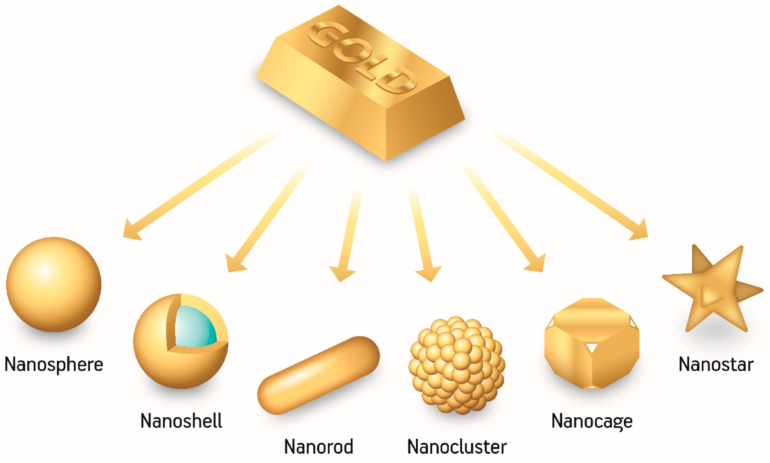Gold is a precious metal that has always fascinated humans. From Priam’s Treasure to the legend of El Dorado, gold—regarded as the noblest of metals—has been a symbol of splendor and wealth in many civilizations. Historically, gold deposits were known to form when metal was transported dissolved by hot aqueous solution flows, or hydrothermal fluids, until it accumulated in some areas in the Earth’s upper crust. The recent discovery of gold nanoparticles in such mineral deposits has brought some doubts on the validity of the classical model.
Now, a paper published in Scientific Reports reopens the scientific debate on the validity of traditional models for the transport of this precious metal in nature. The new study reveals for the first time that gold nanoparticles exposed to hydrothermal fluids have the ability to melt and produce gold nanomelts at temperatures lower (The study was led by experts from the Faculty of Earth Sciences and the Institute of Nanoscience and Nanotechnology (IN2UB) of the University of Barcelona, the Andalusian Institute of Earth Sciences (IACT-CSIC) and the Department of Mineralogy and Petrology of the University of Granada. It also has the collaboration of the Scientific and Technological Centers of the UB (CCiTUB) and the Center for Scientific Instrumentation of the University of Granada (CIC).
Gold, the most precious noble metal
In the 8th century, Jabir ibn Hayyan, the great alchemist of the Islamic world, described the purification of gold and the obtaining of pure mercury from cinnabar. In the 16th century, Georgii Agricolae’s “De ortu & causis subterraneorum” had already established how gold was transported in the Earth’s upper crust as species dissolved in hydrothermal fluids—hot aqueous solutions between 50ºC and 500ºC—with features that depend on the geological context and the depth at which these aqueous solutions are found (generally of the order of kilometers below the Earth’s surface).
Most of the world’s gold deposits have been formed by this mode of transport. However, gold can also accumulate when primary gold deposits are eroded away once they are exposed to the surface by tectonic processes on land, resulting in the famous gold nuggets that prospectors found along riverbanks in the height of the gold rush.
Although John Turkevich succeeded in synthesizing gold nanoparticles in the 1950s, it was not until forty years later, in the early 1990s, that they were documented in natural gold deposits. Specifically, these nanoparticles were found in a type of deposit with high concentrations of gold known as the bonanza type in Nevada (United States). The discovery of these nanoparticles supported the hypothesis that states that gold could be transported as nanoparticles suspended in the fluid rather than as a dissolved species.
“There is a wide variety of hydrothermal gold deposits depending on a number of factors. Globally, the most important are orogenic, Carlin and epithermal gold deposits. However, the characterization of these mineralizing fluids has shown that their ability to dissolve gold is very low. Regardless of their nature, these fluids are incapable of transporting the amount of gold needed to explain auriferous mineralizations, especially those very rich in gold of the bonanza type,” notes Professor Joaquín A. Proenza, from the UB Department of Mineralogy, Petrology and Applied Geology.
“Therefore, the formation of gold deposits cannot be only caused by hydrothermal fluids transporting dissolved gold,” says Proenza, member of the Research Group on Mineral Resources for Energy Transition (MinResET).
When gold nanoparticles melt down
This study describes for the first time the melting process of gold nanoparticles. “This process has been discovered in gold-rich samples from the Cu-Co-Ni-Au deposits of the Habana-Matanzas region (Cuba), which show a large amount of gold nanoparticles. Our research reveals how gold nanoparticles exposed to hydrothermal fluids have the ability to melt and produce gold nanomelts,” says Diego Domínguez-Carretero (UB), who is the first author of the article and is working on his doctoral thesis under the supervision of Joaquín A. Proenza and Antonio García Casco (University of Granada).
“Our study describes for the first time the whole formation process of the gold nanoparticles: specifically, the release of the nanoparticles from the mineral in which they were included, the exposure to the hydrothermal fluid and subsequent melting, and finally, the remobilization by auriferous nanofusions immiscible with the hydrothermal fluid,” say the researchers.
To obtain these results, the team has applied a combination of classical techniques (optical microscopy and field emission scanning electron microscopy) together with other more innovative techniques (hydro-separation, focused ion beam, high-resolution transmission electron microscopy). These analytical techniques are available at the CCiTUB, at the Advanced Microscopy Laboratory of the University of Zaragoza and at the CIC.
“To date, the only example of the formation of gold nanomelts required other elements, such as bismuth (Bi), tellurium (Te) or antimony (Sb), which are not always concentrated together with gold in many mineral deposits. The study details for the first time the sequence of transformation of gold nanoparticles to gold nanocrystals without requiring other elements, such as Bi, Te or Sb.”
According to the authors, “this paradigm shift provides a better understanding of the origin of gold and, consequently, helps to establish more realistic genetic models. Establishing the genesis, that is, to understand the complex geological processes involved and the factors that condition the formation of a mineral deposit, is an essential aim for a mineral deposit geologist.”
“Gold mining, like any other type of mining, feeds on these genetic models to establish exploration campaigns to find new deposits,” concludes the research team. This is an innovative line at a national and European level, dedicated to the investigation of the influence of metallic nanoparticles in the formation of critical mineral deposits, developed in collaboration with the researcher José María González Jiménez, from the Andalusian Institute of Earth Sciences.
More information:
Diego Domínguez-Carretero et al, A track record of Au–Ag nanomelt generation during fluid-mineral interactions, Scientific Reports (2023). DOI: 10.1038/s41598-023-35066-y
Provided by
University of Barcelona
Citation:
Study describes the melting of gold nanoparticles in gold-bearing fluids in the Earth’s crust (2023, June 12)



